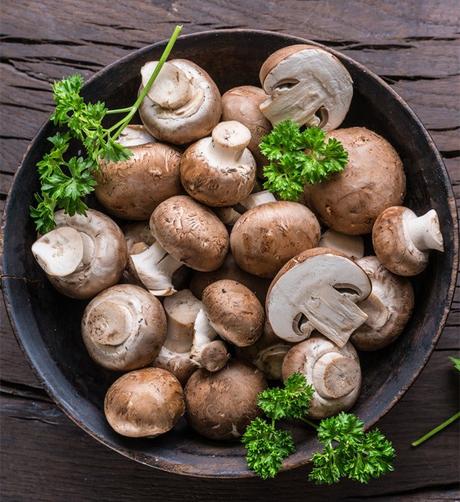
Cremini mushrooms are an edible mushroom variety with a meaty texture and a mild, earthy, savory flavor. They're the same type of mushroom as white and portobello mushrooms, just at a different stage of maturity.
These mushrooms can be used in a number of recipes ranging from pasta, casseroles, tarts, and salads to soups, sauces, gravies, and more. If you've run out of this multi-purpose ingredient, here's a list of some wonderful cremini mushroom substitutes to get the same effect in your recipe.
1. White Mushrooms
White mushrooms, also known as button, table, or champignon mushrooms, are a younger version of cremini mushrooms. They're similar in shape and size to cremini mushrooms but are a little less chewy and more gentle-flavored. But if you pair them with the right ingredients, they can come pretty close to the developed, intense savory flavor of cremini mushrooms.
You can use white mushrooms as a 1:1 stand-in for cremini mushrooms in salads, dipping sauces, stir-fries, pasta, stews, burgers, and other dishes. Make sure to sauté them with herbs like basil and thyme to produce a dish that's closest in flavor to cremini mushrooms. They're also easy to find in most supermarkets, which is a great plus.
2. Portobello Mushrooms
Portobello mushrooms, also known as giant cremini or portobellini mushrooms, are the fuller version of cremini mushrooms. This variety of mushrooms is widely available and is quite popular. They are larger than cremini mushrooms and have a meaty texture. But, because they have a similar earthy mushroom flavor, you should be able to easily substitute one for the other in a variety of recipes.
You can use portobello mushrooms to elevate sauces, pizzas, soups, and salads. Keep in mind that this luscious mushroom type has high water content and might lose form if cooked for too long. So, save them for cooking methods that call for grilling, roasting, or baking to preserve their flavor and texture.
3. Shiitake Mushrooms
Shiitake mushrooms, also known as forest, black, Chinese black, or oak mushrooms, are a staple in Asian cuisine. They look very similar to cremini mushrooms, but they have a slightly mild yet complex flavor profile. However, because they have the same meaty texture and earthy taste, they can be used as a replacement for cremini mushrooms in a pinch.
You can sauté shiitake mushrooms in butter and flavor them with spices to elevate their appeal, then add them to pasta, stir-fries, and dishes where they're used as a secondary ingredient.
However, bear in mind that the spongy texture of these soft, brown mushrooms can make them harder to chew. So, if the texture is an issue for you, feel free to experiment with other options before trying this one.
4. Oyster Mushrooms
Oyster mushrooms, also known as King oyster mushrooms, have an off-white color and a slightly nutty flavor with strong umami undertones. They're flavorful and meaty, and they're versatile enough to be used in a variety of dishes.
When substituting oyster mushrooms for cremini, keep in mind that their bigger size will be noticeable in certain dishes. The size also results in these mushrooms taking longer to be prepared. Their soft skin and light "fishy" flavor may also not be agreeable for discerning palates. It's a better idea to use oyster mushrooms in soups, stir-fries, stews, and seafood-based recipes and gravies.
*You should know, oyster mushroom spores might cause allergic reactions in some people. So, make sure you check for allergies before using this ingredient.
5. Porcini Mushrooms
Porcini mushrooms have a strong aroma, delicate flavor, and thick texture. Because they share many of the same characteristics as cremini mushrooms, they work as an excellent substitute for the original ingredient. Porcini mushrooms are also smaller, so they won't alter the appearance of your food.
When using porcini mushrooms as a substitute for cremini mushrooms, make sure to roast, sauté, or stew them before adding them to dishes that will benefit from their bolder flavors. Keep in mind that they're porous, and thus, water-absorbent. Since porcini mushrooms tend to release a lot of water while cooking, you should give them a brief rinse and then dry them with a paper towel before using them in your recipes.
Do you want to add more vegetables to your diet? Try these non-mushroom substitutes to get the same earthy, nutty, and subtle flavors of cremini mushrooms in your dishes.
6. Eggplant
Eggplant, also known as melongene or Garden egg, has no resemblance to cremini mushrooms in terms of appearance, but it does have a similar flavor profile and texture, making the veggie a good stand-in for cremini mushrooms.
You can sauté, deep fry, or roast this extremely versatile ingredient to enhance its meaty texture and make it taste more like the real deal. It'll be a welcome addition to any main course, side dish, or topping, adding depth of flavor to any cuisine. Keep in mind that because eggplant has a firm and tough texture and higher moisture content, it can take longer to cook.
7. Cauliflower
Cauliflowers have a robust, velvety dense texture and a similar earthy, bittersweet flavor to cremini mushrooms. It will offer more or less the same bite to any recipe (especially meat-based) that calls for cremini mushrooms. Cauliflower also pairs exceptionally well with herbs and spices to enhance the flavor profile of dishes.
This versatile substitute can be a great addition to soups, stir-fries, sauces, and dishes where cremini mushrooms are served as a side or a secondary ingredient. While it won't give your dish a distinct mushroom flavor, it will provide some crunch and chew in one flavor-packed bite, especially when roasted or sautéed. And because it's white, like cremini, it also won't alter the appearance of your dish.
*This veggie can trigger an allergic reaction, so proceed with caution.
